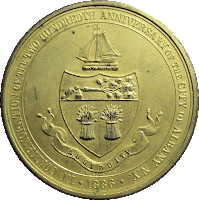1886 Albany, N.Y. Bicentennial Medals
| The celebration for the Bicentennial of Albany New York must have been quite the event! Two large format programs were published, several medals (including those by George H.) were struck, and a 461 page volume ("Albany Bicentennial, Historical Memoirs" by A. Bleeker Banks) was published in 1888. The medals by George H. I am going to assume were the official medals for the celebration because of the following excerpt from page 63 this book - "The Committee on Medals presented the design that had been adopted. The scene represents Governor Dongan seated at his desk with Livingston at his right and Schuyler at his left, and is founded on the statement of the initial pages of our city records that Livingston and Schuyler went to New York for the city charter. Livingston was the son of a Scotch minister and was then about thirty years of age. He is represented in Puritanical dress. Schuyler is attired in military costume. Dongan's hat and sword hang on the wall near the old-fashioned clock. The seal of the city and the inscription "In memory of the two hundredth anniversary of the city of Albany, N. Y., 1886," are represented on the other side. They recommended that the medals be put on sale, the white metal for twenty-five cents and the bronze for one dollar each." |
1886 Albany Bicentennial Medals
|
The following quote is from page 426 of
A. Bleeker Banks' book on the celebration and list the composition and
number of medals struck for the celebration -
"The
number of medals struck from the die, which was defaced on the 22nd
day of July, 1886, is as follows: Ten gold medals; eight silver
medals; thirty six in bronze, gilded with a Florentine finish; thirteen
hundred in bronze, and eleven thousand in white metal. The medals
thus described were one-eighth of an inch in thickness.
A few,
three-sixteenths of an inch in thickness, were issued as follows: one
in copper, three in bronze and thirty-six in bronze struck up in
gold." There is some discrepancy between this listing and pieces I have
seen, especially the thickness.
|
Gold, 51mm
IMAGE NEEDED
The only gold example I have any record of
was sold in a Johnson and Jensen sale, 12/13/1981. It was in it's
original case of issue with
"Geo H. Lovett, Medalist, 192 Bway, NY" in gold inside lid.
Anyone with information on this please contact me.
|
Silver, 51mm
IMAGE NEEDED
| One of the silver examples, in the original presentation case, was sold in the Presidential Coin and Antique Auction 51, December of 1991. Another silver example appeared in the same Johnson and Jensen sale as the gold example above. |
Copper alloy (99.28%, .35%tin, .15% nickel, .14% lead), 51.1mm, 4.85mm (.190") thick
| This appears to be one of the three thick planchet bronze examples but analysis shows it to be nearly pure copper. Were any actual bronze examples struck? |
Copper, 51.1mm, 4.13mm (.163") thick
| This example was subjected to mettalurgical analysis and determined to be nearly pure copper (.997). The thickness is not quite the 3/16" listed above. |
Copper?, 51.1mm, 3.89mm (.152") thick.
| This piece has more of a copper than a bronze look to it. The thickness is somewhere between the 1/8" and 3/16" |
White Metal, 51mm, 3.48mm (.143") thick
Gilt (86.87% tin, 5.84% silver, 3.78% copper, 3.5% gold)
51.1mm, 3.48mm (.136") thick
| The gilt piece above is close to the 1/8 thickness listed above but the composition is definitely not "bronze, gilded with a Florentine finish", seems more like white metal. The description I find for a "Florentine finish" is parallel lines engraved into a finish to reduce reflectivity. These can be seen under high magnification. |
This piece could be described as 'bronze struck up in gold'
and is close to the 3/16 of an inch'
Gilt copper (94.8% copper, 5.2% gold) 51.1mm, 4.2mm (.15 inches) thick
thickness is close to 1/8 inch and it has much more of a matte finish
the the previous one.
Bronze and gilt in original case of issue
This is the only original cased set I have seen. The gilt medal is 5.25 mm thick
which is close to the 3/16 inch described above.

















